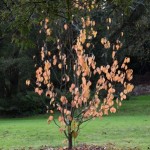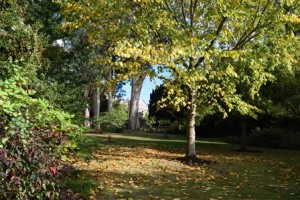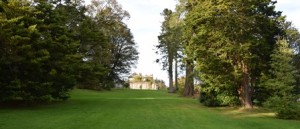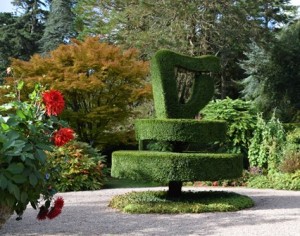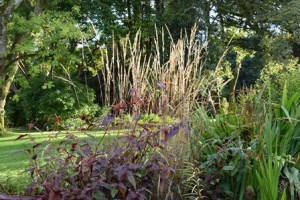16 Autumn Gardens
Posted by Christine on Oct 16, 2014 in Ireland | 0 comments
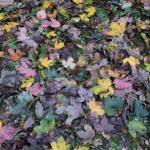 “Fall” is the more common term in English, fhómhair in Irish (pronounced like the English “four” but with a more obvious diphthong) but “fall gardens” even if lower-cased sounds like THE fall in THE garden and I don’t mean that. I mean that time of year “When yellow leaves, or none, or few do hang / Upon the boughs which shake against the cold,” that time of year when gardens start to sag and fade but are still beautiful, maybe even more so, as their colors blend with the red and orange and yellow and brown leaves on the ground, when the silhouettes of trees and shrubs start to emerge from their foliage, “Bare ruined choirs where late the sweet birds sang.”*
“Fall” is the more common term in English, fhómhair in Irish (pronounced like the English “four” but with a more obvious diphthong) but “fall gardens” even if lower-cased sounds like THE fall in THE garden and I don’t mean that. I mean that time of year “When yellow leaves, or none, or few do hang / Upon the boughs which shake against the cold,” that time of year when gardens start to sag and fade but are still beautiful, maybe even more so, as their colors blend with the red and orange and yellow and brown leaves on the ground, when the silhouettes of trees and shrubs start to emerge from their foliage, “Bare ruined choirs where late the sweet birds sang.”*
What I love about visiting gardens in the fall is seeing everything in transition, the summer waning, the winter setting in, and even hints of spring amid the long shadows and touches of cold. The stems and blooms that have long died linger as pale brown ghosts alongside the rich fall flowers—here in Ireland they include black-eyed susans, michaelmas daisies, hardy plumbago, californian lilac, cyclamen, lilyturf ,and so many more. I didn’t know there were autumn crocuses until I saw a carpet of them yesterday.
Recently I visited two autumn gardens, one at Mount Stewart on Strangford Lough in County Down and another at Kilmacurragh in County Wicklow. Mount Stewart was the seat of the Marquess of Londonderry and is now in the possession of the National Trust. The neo-classical house and its contents and the extraordinary grounds are very well preserved, and on the day I visited, very well used by the public. A fall festival was going on with food vendors, children’s games, traditional singing and dancing, and a state-fair style competition for baked goods, garden produce, and flower arranging. The gardens were designed by the imaginative Edith, Lady Londonderry and include a Shamrock Garden with topiary in the shapes of Irish symbols and the famous Dodo Terrace. I’ve seen them vivid and gorgeous in the full intensity of a hot July day, but I think I like them even better at this time of year.
By contrast, the grounds at Kilmacurragh were almost deserted, but this place is less well known than Mount Stewart and much less geared to visitors. The house and grounds now belong to the National Botanic Gardens thanks to one of the estate’s heirs, Tom Acton, who planted a remarkable arboretum on his land in the 1850s that is now come to fruition. The house, built at the end of the seventeenth century in the Queen Anne style, is a splendid ruin—not burned or pulled down during the 1920s like so many “Big Houses,” but neglected over the years and further weakened by weather and accidental fire. The gaping roof and leaning walls are mostly a home for birds now, but enough of the structure survives to suggest the elegant proportions of this once lovely estate. When I was there on a late October afternoon, the trees and the garden were turning towards winter and the empty house seemed especially sad.
For the finest fall colors and atmosphere, you need to be somewhere with a more northerly climate, like Vermont or even northern Michigan and Wisconsin. With average temperatures between 40 and 63 degrees all year long and lots of nondeciduous plants and palm trees thanks to the Gulf Stream coming this way, the climate in Ireland is just too mild for a really dramatic fall display in its gardens and forests. Ireland is the “emerald Isle” all year long. But everywhere you look, in a planned garden or in the city, there’s something beautiful and melancholy to take in: a slab of unremarkable sidewalk becomes a palette, forgotten deadheads catch the light, plants living and dead lean into each other’s spaces. The ugly cement fountain outside my building was looking lovely and autumnal this morning with a smattering of yellow leaves floating on the water and gusts of wind tossing its otherwise orderly sprays.
*Shakespeare’s Sonnet 73 is actually about aging, but no one describes fall better.
Sonnet LXXIII
William Shakespeare
That time of year thou mayst in me behold
When yellow leaves, or none, or few, do hang
Upon those boughs which shake against the cold,
Bare ruined choirs, where late the sweet birds sang.
In me thou see’st the twilight of such day
As after sunset fadeth in the west;
Which by and by black night doth take away,
Death’s second self, that seals up all in rest.
In me thou see’st the glowing of such fire,
That on the ashes of his youth doth lie,
As the death-bed, whereon it must expire,
Consumed with that which it was nourish’d by.
This thou perceiv’st, which makes thy love more strong,
To love that well, which thou must leave ere long.

